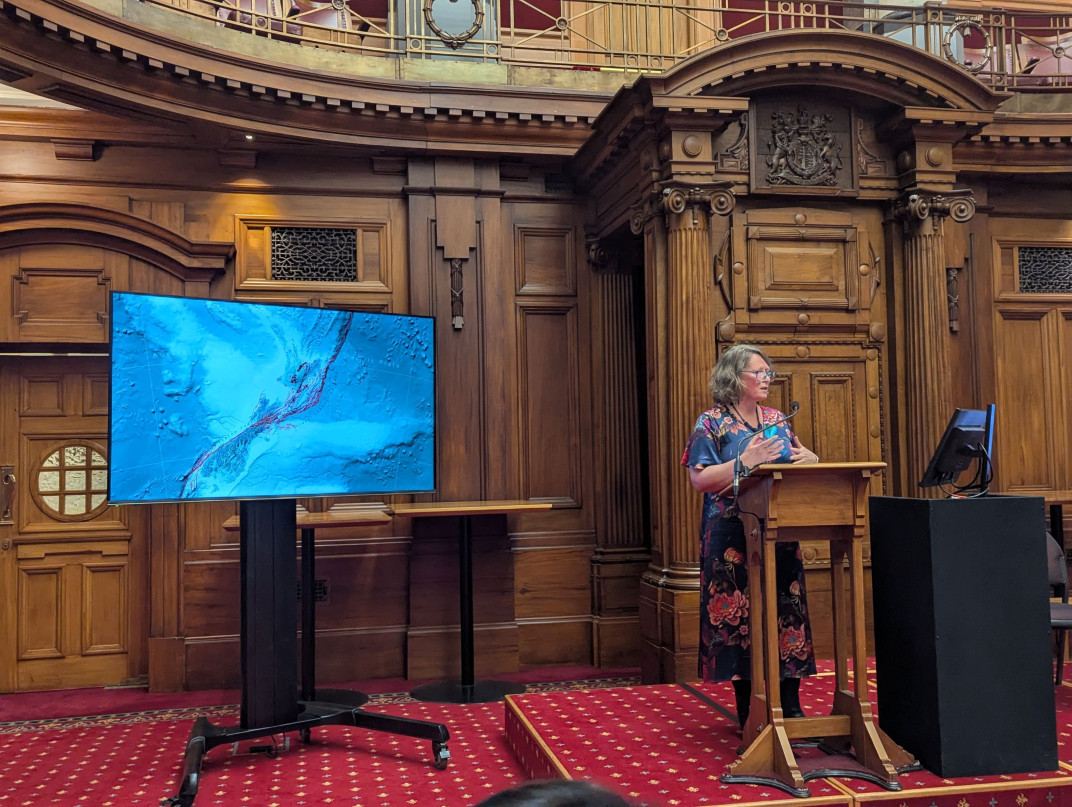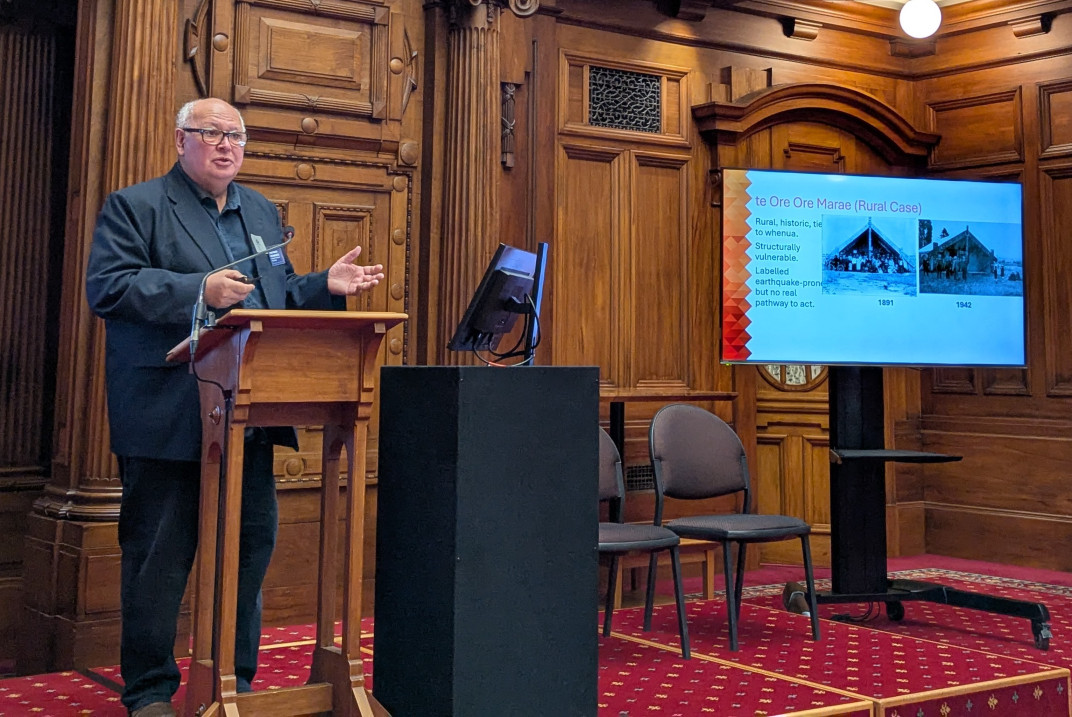Earthquakes: Prediction and recovery
The sixth event in 2025’s Parliamentary Science Forum was held on 23 Hōngongoi July. Dr Phaedra Upton of Earth Sciences New Zealand told MPs about earthquake forecasting and important faults under our feet. Professor Regan Potangaroa from AUT described the important roles marae play in civil defense and how marae are let down by the earthquake-prone buildings code.

Dr Phaedra Upton speaking to MPs
Mitigating the impact of tectonic movement
Dr Phaedra Upton, Land and Marine Geoscience Theme Leader, Earth Sciences New Zealand
Dr Phaedra Upton outlined how science can reduce the long-term costs of natural hazard events and help New Zealand build safer, more resilient communities.
Dr Upton opened by addressing a reality many New Zealanders live with daily: we are a tectonically active nation. Our dramatic landscapes exist because we sit atop a plate boundary, but that also makes us the 2nd most disaster-prone country in the world after Bangladesh. Earthquakes, landslides, and weather extremes are inevitable. But disasters, she said, don’t have to be. The difference lies in how well we understand our land, and how we plan with that knowledge.
She highlighted that since 2010, 97% of the Government’s expenditure on natural hazards has been spent on responding to and recovering from events. Only 3% has gone toward reducing risk and increasing resilience[1]. Scientific evidence from around the world shows that for every $1 spent on mitigation, up to $11 can be saved in recovery costs[2]. Dr Upton challenged MPs to reverse this trend by putting science at the centre of proactive planning and decision-making.
She explained how Earth Sciences New Zealand is using cutting-edge research to map faults and landslides, forecast earthquakes and cascading impacts like ground shaking and liquefaction, and develop national models like the National Seismic Hazard Model. These tools support better building codes, land-use planning, and infrastructure design.
Dr Upton shared two case studies. The first examined the 2016 Kaikōura earthquake, which was one of the most complex earthquakes ever recorded globally. The data gathered from this event reshaped how scientists understand fault ruptures and directly informed updates to the National Seismic Hazard Model. The second focused on Auckland’s northern growth corridor, where new LiDAR data has allowed researchers to map over 1,200 previously unknown landslides. This knowledge is critical for guiding safe future development in a region facing both population growth and increasing climate risk.
Throughout her presentation, Dr Upton stressed that resilience starts with understanding. By investing in high-quality data, new technologies, and science-led planning tools, New Zealand can better forecast future hazards and reduce the risks they pose to people, homes, and infrastructure.
Her message was clear: the most effective and affordable time to plan for resilience is before disaster strikes. New Zealand already has the scientific capability to make this shift; what’s needed now is policy commitment and investment to match.
“With climate change increasing our exposure to natural hazards, we have a choice,” Dr Upton said. “We can keep paying twice to build and then rebuild, or we can invest in science, plan smarter, and build a safer future for our communities."

Professor Regan Potangaroa speaks to MPs
Rising from the earth: marae, resilience, and seismic justice
Professor Regan Potangaroa, Te Wānanga Aronui o Tāmaki Makau Rau | Auckland University of Technology
Professor Regan Potangaroa has 45 years’ experience spanning structural engineering, architecture, disaster response, and academia. He has led over 200 humanitarian deployments in 22 countries and pioneered innovative assessment methods for traditional timber structures like wharenui. At Parliament he described his work with wharenui, marae:
"We’re getting better at predicting earthquakes. The science is advancing, we now know more about where, how often, and how severely they’ll strike. But the question I want to ask is: what are we doing with that knowledge? Because while prediction is necessary, it’s not sufficient. We must talk about the transition; how do we move communities from earthquake-prone to earthquake-prepared?
Nowhere is this tension more visible than in our marae. These buildings are central to Māori culture, yes, but they are also part of the national landscape, architecturally distinctive, socially vital, and increasingly relied upon during crises. We’ve seen it in Christchurch, in Kaikōura, and most recently in the floods on the East Coast. When disaster strikes, marae open their doors. They become shelters, kitchens, coordination hubs. And in many cases, they are the only large, accessible facilities within vulnerable communities.
But here’s the problem: we’ve created a system where the very buildings we depend on are being left behind. Through the Earthquake-Prone Buildings Act, we have labelled marae as liabilities, without providing the pathways or resources to protect them. The policy was well-intentioned, but it’s landed poorly. It asks for engineering reports communities can’t afford, upgrades they can’t fund, and compliance timelines that feel out of step with the lived reality of Māori communities. Instead of strengthening marae, we’ve stalled them.
What I want to put forward is a shift in mindset. We need to stop seeing marae as seismic liabilities and start recognising them as essential civil defence and cultural infrastructure. That means rethinking how the Earthquake-Prone Buildings Act applies and creating dedicated retrofit pathways and funding streams for marae, developed in partnership with iwi, hapū, and engineers.
Because if these buildings fall through the cracks, it’s not just timber that’s at risk, it’s whakapapa, community cohesion, and our shared resilience.
If we can map faults with precision, we can map a path forward. But we must choose to act. Kei a tātou te mātauranga. Kei a tātou hoki te kawenata, the knowledge is there, but so is the responsibility."
Professor Potangaroa’s work protecting marae is summarised in this video.
[1] https://www.iag.co.nz/newsroom/news-releases/iag-sapere-report-nz-natural-hazard-spending
[2] NIBS Multi-Hazard Mitigation Council. 2019. Natural hazard mitigation saves: 2019 report. Washington (DC): National Institute of Building Sciences; [accessed 2023 Oct]. https://www.nibs.org/files/pdfs/NIBS_MMC_MitigationSaves 2019.pdf
